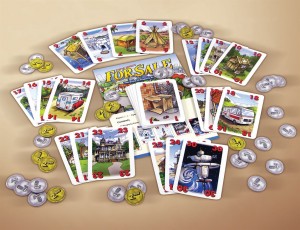Review: For $ale
Posted by James (admin) on August 10th, 2010
 For $ale is a fast and light auction game for 3 to 6 players with an excellent difference.
For $ale is a fast and light auction game for 3 to 6 players with an excellent difference.
The game primarily consists of two decks of cards: One deck of properties and the other of cheques. Each property card has a value ranging from 1 to 30 and the higher the value the nicer the property pictured on the card, i.e. the value 1 card shows a cardboard box, value 10 shows a basic log cabin, value 29 is a castle. Each cheque card has a value ranging from zero to $15,000. In addition, there are some cardboard tokens which are cash and each player starts with $18,00.
The game is made up of two halves. First, the players bid for the properties using their cash. Each round a number of cards equal to the number of players cards are laid out face-up in the middle of the table. Going clockwise, players bid by either increasing the previous bid or passing. If a player passes, they take the lowest value property card and pay half of their bid to the bank. The last player left in each round wins the highest value card but must pay the full amount of their bid to the bank.
When the property deck runs out, the second half of the game begins where players use their properties to try and gain cheques. Each round a number of cheque cards equal to the number of players cards are laid out face-up in the middle of the table. Simultaneously, players reveal one property card from their hand – the highest property value gets the highest value cheque and so on. When the cheque deck runs out, players add up their cheques and the highest total wins.
Note that, before the game begins, a number of property cards and cheque cards are randomly removed from the game without being seen so (a) there are enough cards for all the players, and (b) you don’t have full knowledge of which cards may not be present.
 Overall, For $ale is a very simple game both to play and to learn, but manages to put the players through some excruciating decisions which are also very humorous – usually for the other players. Not knowing how much cash players have in hand means you’re never quite sure whether to bid higher – you want to force others to pay as much as possible for their cards but do you risk pushing it so high tht you’re the one who ends up paying the full cost?
Overall, For $ale is a very simple game both to play and to learn, but manages to put the players through some excruciating decisions which are also very humorous – usually for the other players. Not knowing how much cash players have in hand means you’re never quite sure whether to bid higher – you want to force others to pay as much as possible for their cards but do you risk pushing it so high tht you’re the one who ends up paying the full cost?
The reason the game works is that the mixture of the cards on show sets the tone of the round and makes you bid differently. If the cards are quite similar values, then why bother bidding high seeing as you’ll get a card that’s not much worse than anyone else’s that round. However, if one card is of a high value and the other two are low then there’s a lot to think about as you may get something rubbish if you have a high but second-place bid. (It reminds me a bit of a game theory where a guy asked his colleagues to bid for a $1 note, the only catch was that the winner would pay their bid and get the $1, but the second highest bid would also pay their bid too and get nothing. People ended up bidding more then $1 just so they didn’t come second and pay for nothing.)
The missing cards in each game add an extra element of uncertainty, especially if you don’t remember what value properties were bid on. Some gifted players may be able to card count to give them an edge but this game is meant to be fun and really doesn’t warrant that much effort, plus the missing cards reduce that potential advantage.
If I had to find criticisms about the game, it would be the cardboard cash tokens as these stick in your hands a bit and plastic chips (like in No Thanks) would have been easier to drop out of your hand when increasing bids (as your money is hidden). Also, the cash tokens are mainly $1,000 each but players start with 14 x $1,000 plus 2 x $2,000 – I don’t quite understand the $2,000 tokens. Why not just have a few more $1,000 tokens rather than a couple of $2,000 each so you don’t have to keep looking in your hand? Anyway, these are not a big deal at all and didn’t spoil the game’s entertainment at all. Plus, whilst the total amount of components in the game may not quite justify the full price but the fun that the game provides does.
For $ale, was really fun, very quick and playabale with any group. I’m really pleased I was introduced to For $ale – so much so I bought a copy at the shop where the regular games night is held. For $ale? Sold.
James.
[Played 3 times with 3 players]


August 10th, 2010 at 4:05 pm
Great game! So easy to teach but a challenge to play right. We always play this at least three times in a row.